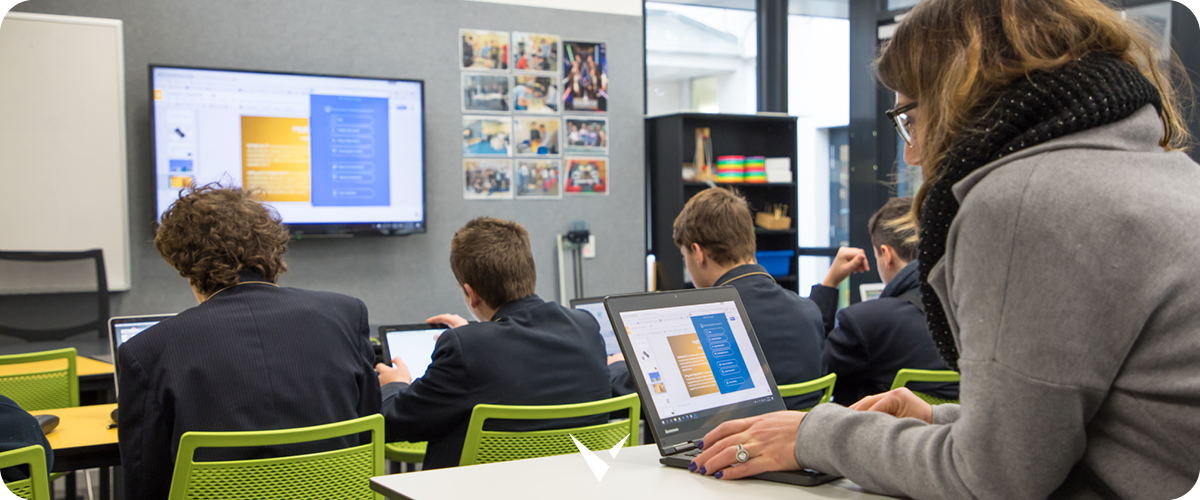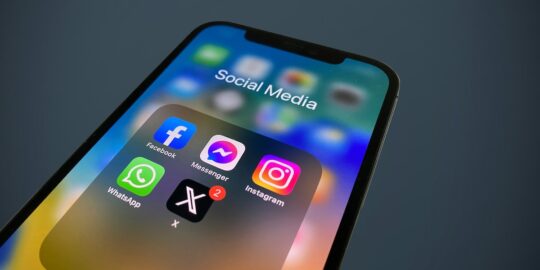
The modern classroom has evolved beyond textbooks and lectures. Students now interact with history at the touch of a screen, visualize once-abstract concepts with ease, and embrace learning experiences that know no physical boundaries. This evolution is fueled by cutting-edge technology. Recent data shows that 92% of teachers believe technology significantly improves the classroom experience by enhancing student engagement and personalizing the learning experience
The demand for classroom technology has skyrocketed, especially in response to shifts towards blended learning. This, coupled with the rapid growth of the EdTech industry, projected to reach $404 billion by 2025, highlights the potential of digital tools to transform education. From adaptive learning to immersive experiences and dynamic digital signage, today’s classrooms are equipped to empower students and teachers, preparing learners for a tech-driven future. Let’s explore the diverse technologies revolutionizing educational spaces and making learning more engaging and effective.
Key Technologies for Classroom Use
The integration of technology within educational settings presents educators with a wealth of tools to elevate the learning experience. Here’s an overview of some of the most impactful technologies transforming teaching and learning:
1. Adaptive Learning Platforms: Powered by artificial intelligence, these platforms revolutionize instruction by tailoring learning paths to individual student needs. Algorithms analyze each student’s knowledge and skill levels, providing customized content, practice exercises, and feedback for a truly personalized approach. The significant growth of this market, with a projected value of $9 billion by 2028 reflects the immense potential of adaptive learning to address diverse student needs.
2. Game-based Learning: By incorporating elements of game design, such as points, rewards, and levels, game-based learning transforms education into an engaging and interactive experience. Gamified learning experiences are reported to more engaging than traditional training exercises, leading to a 50% improvement in student productivity This approach fosters student motivation, promotes problem-solving skills, simplifies complex concepts, and adds an element of fun that resonates with learners.
3. Augmented and Virtual Reality: Augmented Reality (AR) and Virtual Reality (VR) offer immersive and experiential learning opportunities unlike any seen before. AR seamlessly overlays digital information onto the real world, while VR creates fully simulated environments. These technologies bring abstract concepts to life, facilitating deeper understanding across diverse subjects, from history and science to art and literature. A compelling 97% of students express interest in studying VR-enabled courses, highlighting a strong student demand for tech-enhanced education.
4. Digital Signage: Gone are the days of static bulletin boards. With many educational institutes recognizing digital signage as a critical element of communication, these dynamic displays are transforming school environments into communication hubs. Strategically placed throughout campuses, they deliver a wide range of content, including:
- Timely Announcements: Eliminate confusion and ensure everyone is on the same page with real-time updates on events, schedule changes, and important reminders.
- Student Success Stories: Celebrate achievements, showcase student artwork and projects, and promote a culture of recognition.
- Inspirational Content: Share motivational quotes, highlight historical figures, or feature engaging multimedia presentations relevant to different subject areas.
- School Branding: Reinforce school spirit, values, and identity with consistent messaging and visuals.
- Emergency Alerts: In the event of a crisis, digital signage can become a critical tool for rapidly disseminating emergency information.
By adopting cutting-edge technologies like adaptive learning platforms, game-based learning, augmented and virtual reality, and digital signage, education is being transformed. These innovations enhance personalized learning, make education more engaging, visualize complex subjects, and improve communication across campuses. They are pivotal in boosting student engagement and outcomes, highlighting the transformative power of integrating technology into classrooms.
A Case Study in Success: Nova Trust’s Educational Tech Transformation
Like many educational institutions, Nova Education Trust recognized the potential of digital technology to enhance learning and communication. Vivi’s digital signage made updates easy, improved engagement, lightened IT work, and got more parents involved, showing technology’s power to change education. Read more about Nova Education Trust’s digital transformation.
Improving Teacher and Student Experience with Technology
Technology holds the immense power to transform the overall experience for both educators and students. Let’s explore some of the most significant benefits:
- Teacher Professional Development: The widespread shifts to remote and hybrid learning during the pandemic accelerated teacher adoption of digital tools. 87% of K-12 educators say their tech skills improved during the pandemic. By providing teachers with ongoing professional development and support, schools unlock the potential for even more innovative and engaging learning experiences.
- Enhanced Learning Outcomes: Research suggests a correlation between internet-connected computers in the classroom and increased academic scores. Studies indicate that students in schools with greater access to technology may see an increase of up to 30 points in PISA assessments. This highlights the potential for technology to positively impact student achievement and long-term outcomes.
- Student Empowerment: Technology places students at the center of their educational journey. Adaptive learning platforms support student agency through personalization. Digital tools foster creativity and offer diverse avenues for self-expression. Access to online resources allows students to explore their interests and expand their knowledge beyond the traditional classroom.
The Future of Classroom Technology
The integration of technology into education is accelerating, with new tools and approaches constantly emerging. Here are some of the key trends shaping the future of the classroom:
- Personalized Learning Powered by AI: Adaptive learning platforms fueled by artificial intelligence will become even more sophisticated. These systems will analyze student data in real-time, adjusting instruction to match each learner’s individual needs, strengths, and learning pace. This hyper-personalized approach has the potential to optimize learning outcomes and make education more accessible for a diverse range of learners.
- Immersive Learning through VR and AR: Virtual reality (VR) and augmented reality (AR) will move beyond novelty and become powerful tools for immersive, experiential learning. Imagine students stepping into historical simulations, conducting virtual science experiments, or exploring far-off places. These technologies will make learning more engaging, interactive, and memorable.
- The Power of Gamification: By incorporating elements like points, levels, and rewards, gamification can transform the learning process. Game-based learning motivates students, fosters problem-solving skills, and makes educational content more engaging and accessible. Expect to see even more innovative and effective gamification strategies integrated into the classroom experience.
- Enhanced Accessibility and Inclusion: Technology is breaking down traditional barriers to education, making it more accessible and inclusive than ever before. Digital platforms and tools enable remote learning, offering opportunities for geographically isolated or physically disabled students. Educational software often includes features like text-to-speech for those with reading difficulties or sign language avatars for the deaf, ensuring education is becoming more equitable for all students.
Technology as a Tool for Teachers: While exciting advancements are on the horizon, it’s vital to remember that technology is a tool, not a replacement for skilled educators. These new technologies will empower teachers to provide more personalized support, create dynamic learning environments, and better understand the progress of individual students.
Elevating Education with Technology: Is Your School Ready?
The transformative power of technology within education is undeniable. From personalized learning platforms that adapt to each student’s needs, to immersive virtual and augmented reality experiences, to the power of gamification, the future of education is intrinsically linked to technological innovation. These advancements promise to reshape the way we teach and learn, creating a more engaging, dynamic, and inclusive learning environment for all.
To fully embrace this transformation, educators must be willing to adopt a forward-thinking approach, integrating technology thoughtfully and purposefully to support, rather than replace, skilled instruction. When used strategically, technology becomes a powerful tool in every teacher’s arsenal, allowing them to personalize learning, inspire creativity, and foster a collaborative and connected classroom community.
Transforming Your School with Vivi
Vivi’s intuitive digital signage and screen-mirroring solutions are designed with the unique needs of educational environments in mind. With Vivi, you can:
- Enable Real-Time Collaboration: Facilitate interactive lessons and discussions by allowing students to share their screens and work together in real time.
- Engage Your Community with Digital Signage: Transform static bulletin boards into hubs for announcements, student work, school news, and inspirational content.
- Simplify Creating and Sharing Content: Easily create, schedule, and update digital signage content with a user-friendly interface, requiring no design experience.
- Centralize Control and Support Role-based Permissions: Give the right staff members the ability to control the content, while technology teams manage the platform, saving time and ensuring consistency.
Ready to take the next step? Schedule a demo for your school! Let Vivi transform your classroom into a future-focused and tech-driven learning space.



